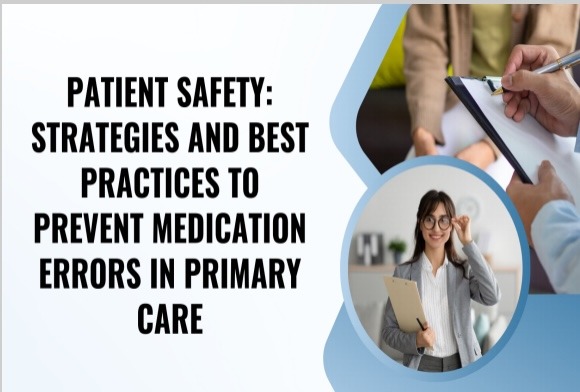Patient care must always come first. It is the responsibility of every doctor, especially primary care physicians, to keep their patients safe. Thus, to ensure patient safety, medication errors should be avoided at all costs.
Prescription and dosage mistakes happen unintentionally. They may result from a combination of factors including a breakdown in communication, a lack of clearly defined procedures, inaccurate patient information, or a simple human error. Negative medication reactions, hospitalization, and even death could result from these mistakes.
In primary care, medication errors are a major problem because millions of prescriptions are written each year. However, by following standards of care, medical professionals can decrease the likelihood of these types of mistakes.
What Is a Medication Error?
Medication errors are avoidable incidents that can harm patients. They could be about prescription, transcription, dispensing, administration, and monitoring, which can all lead to medication errors. These include prescribing the incorrect medication, administering the wrong dosage, misinterpreting pharmaceutical orders, and ignoring a patient’s allergies or drug interactions.
A medication error, as defined by the National Coordinating Council for Medication Error Reporting and Prevention, is a preventable incident that can lead to inappropriate medication use or patient harm. This occurs when the medication is controlled by a healthcare professional, patient, or consumer.
Common Types of Medication Errors in Primary Care Settings
Medication errors in primary care settings can manifest in various ways, with each containing the potential for catastrophic consequences. Here are a few examples of common medication mistakes:
- Prescription Errors: This happens when physicians prescribe the incorrect substance, dosage, or frequency. Such errors could be caused by illegible handwriting or similar-sounding drug names.
- Administration Errors: This occurs when a healthcare professional administers the wrong dose or route of medication. Distractions, inadequate training, and double-checking can cause errors in administration.
- Medication Reconciliation Errors: Medication reconciliation contrasts a patient’s current and intended medications. This procedure may lead to medication inconsistencies.
4 Best Tips for Preventing Medication Errors
1. Strong Patient-Doctor Relationship
Having a good, healthy doctor-patient relationship helps to enhance medical care. It is important to find primary care doctors who are not just experienced and skilled, but who also communicate effectively with their patients. When you have a credible primary care physician, you will have a primary care doctor that will ensure your safety and health. Having a good relationship with your general physician will allow you as a patient to express your problems, medical history, and treatment preferences. Trust, teamwork, and individualized care can reduce prescription errors and enhance health and wellness in a supportive doctor-patient relationship.
2. Open Communication and Medication Reconciliation
Another way to prevent medication errors is for your primary care provider to have open patient communication. The primary care doctor and patient should be able to share complete and proper information regarding medications, medical history, allergies, and adverse reactions. Medication reconciliation ensures the accuracy of the patient’s medication inventory.
Reconciling medications involves examining a patient’s prescriptions, over-the-counter medications, and supplements. This method identifies duplicate prescriptions and drug interactions, thereby reducing medication errors. By actively participating in open communication and medication reconciliation, patients can contribute to safer medication management.
3. Patient Education and Empowerment
Patient education involves communicating drug instructions, adverse effects, and precautions to patients. Educated patients can make wise decisions and manage their medications. Understanding medications enables patients to recognize inconsistencies, pose pertinent inquiries, and express concerns to their physicians. Patient education emphasizes medication and treatment adherence. Individual education and empowerment enhance pharmaceutical safety and health outcomes.
4. Leveraged Technology
Technology nowadays can also help to enhance the safety of primary care medications. Electronic health records (EHRs), e-prescribing systems, and medication management applications improve pharmaceutical efficiency and safety.
EHRs help physicians make more informed decisions by providing accurate patient information such as drug history and allergies. Handwriting errors are reduced with e-prescribing, enabling pharmacy-provider communication in real-time. Drug management applications remind, track, and educate patients to increase drug safety. By utilizing technology, primary care physicians can improve medication safety, reduce errors, and enhance patient outcomes.
Impact of Medication Errors on Patients and Healthcare Providers

Source: Canva
Every day, the goal of those who work in healthcare is to ensure that their patients remain safe. Patient safety is usually the top priority in any healthcare clinic’s mission statement. However, primary care providers are also human and have flaws. Thus, accidental mistakes are sadly common in the medical field..
Medication errors may have life-threatening consequences for patients. Adverse drug reactions, allergic reactions, and medication toxicity can result in hospitalization, prolonged illness, or even death. Moreover, medication errors can delay treatment or worsen a patient’s condition. Additionally, medication errors can erode patients’ confidence in the healthcare system and induce anxiety. Patients may require additional treatment or hospitalization due to inaccuracy, which may increase their medical costs.
Medication errors can also be difficult for medical practitioners. Recognizing that a mistake caused harm to a patient can induce regret, humiliation, and distress to the primary care doctor. Depending on the severity and consequences of the error, healthcare providers may be subject to legal and disciplinary action. Physicians’ reputations and self-confidence can be negatively affected by medication errors. Litigation and corrective actions may damage the reputations and finances of healthcare organizations.
There are several more possible consequences of medication errors that have not been discussed. Nonetheless, it is evident that these errors, which occur far too frequently, result in unwarrantedly negative outcomes for patients, healthcare professionals, and organizations.
Various options are available for mitigating the effects of these preventable errors. At the organizational level, the management must cultivate a safety culture and develop an error reporting system. As a patient, finding trusted primary care and collaborating effectively is very important.
Conclusion
It is necessary to take a comprehensive approach to reduce the number of pharmaceutical errors in primary care settings. Primary healthcare providers can make their patients’ environments safer by following these tips to lower medication errors and improve patient results. With these preventive steps in place, we can strive toward a future that eliminates prescription errors and ensures that patients receive high-quality, risk-free treatment.
FAQs
How can primary care patients reduce medication errors?
Patients who are knowledgeable and engaged can manage their medications. Patients must report medications, allergies, and adverse effects accurately. They should ask questions, clarify, and convey concerns about medication. Involving and informing patients can reduce medication errors and increase safety.
What are the common causes of medical errors?
Medical errors can be caused by human factors (e.g., miscommunication, fatigue, lack of knowledge), medication-related factors (e.g., confusing drug names, dosage errors), communication breakdowns, system failures (e.g., inefficient processes or technology), and patient-related factors (e.g., inaccurate information, limited health literacy). These interactions frequently result in pharmaceutical errors, highlighting the need for initiatives to improve patient safety in healthcare settings.
How frequent are medication errors in the US?
Medication errors are a widespread problem in US healthcare. According to the National Institutes of Health, medication errors cause death for between 7,000 and 9,000 people each year in the United States of America alone. Hundreds of thousands more people experience an undesirable reaction or other medication-related concern, but most do not report it. Errors like these can lead to patients spending more time in the hospital, incurring larger medical bills, and even passing away. Thankfully, drug errors are becoming less common due to procedures, technology, and patient safety improvements.




